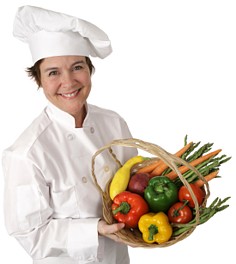Childproofing the Kitchen II
Each room in a house has safety issues that it shares with other rooms, and safety issues unique to its particular function and the way that the household has personalized it. Areas and products that are usually only in or around the kitchen may require special attention. Here are some pointers about kitchen-specific issues:
Appliances
To protect children in the kitchen, consider appliance locks on the refrigerator, freezer, oven, and microwave. In addition, read these specific recommendations:

Food
• Uncooked food—food that is unsafe until properly cooked should not be left in an accessible place, whether it is sitting in its package waiting, or in some stage of preparedness on the cutting board.
• Salt—though in many households a salt container is left accessible on the table because it is used so frequently during meals, half a teaspoon of salt can poison an infant, damaging the central nervous system. Salt is better kept in an out-of-reach cabinet.
• Spices—it is popular to keep spices on an open rack, but if this makes the peppercorns, pepper flakes, etc. accessible to children, you should consider moving them to another part of the kitchen.
• Heated food—you may know that the pizza sitting on the pan just came out of the oven, but it might not be obvious to a child. To prevent burns, keep hot food out of reach.
Garbage
Kitchens are a part of the house where a fair amount of waste is generated. Whether it is placed in a trash container or prepared for compost, it’s important to keep the waste away from children both before and after disposal.
• Food waste—skin or sprouts from green potatoes contain solanine, a toxin; bones, moldy food, raw meat, chicken, and fish scraps, and other food waste should be carefully kept out of children’s reach. A sturdy garbage container with a closed lid is good; placed inside a locked cabinet is better.
High Chair
Use the waist and crotch restraints designed to prevent a child from standing and falling from or in the high chair. If you have an old highchair without these features, add them yourself (you can purchase a strap kit) or replace the highchair.
Pets’ Dining Area
Dogs or cats whose food and water is kept in a corner of the kitchen or a nearby area may not mind sharing their meal (though there is a danger that they may feel threatened and react), but good canine and feline nutrition is not appropriate for a human child. Approaches to this include placing pet food in an area that is not accessible to the child; lifting it from the floor except at short, monitored mealtimes; or using gates to keep the child away from the kitchen while the animals eat.
Written by Mary Elizabeth
Related Home Institute Articles
